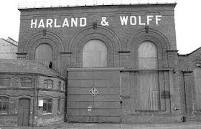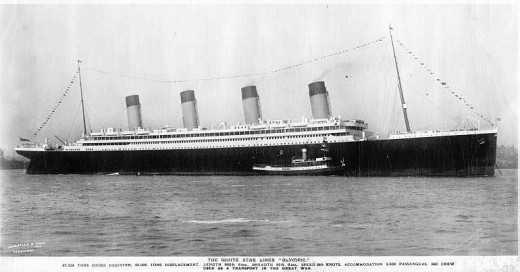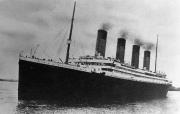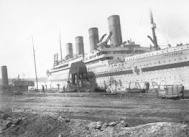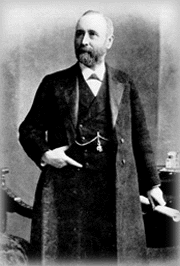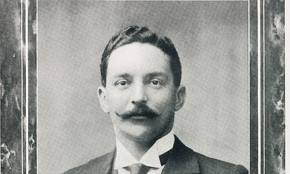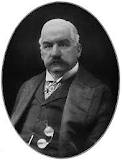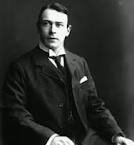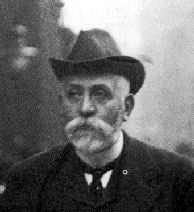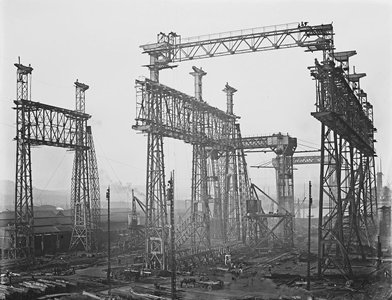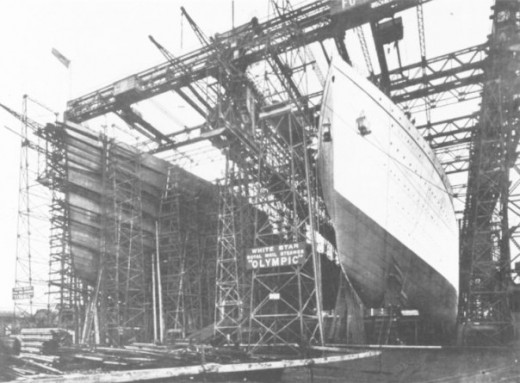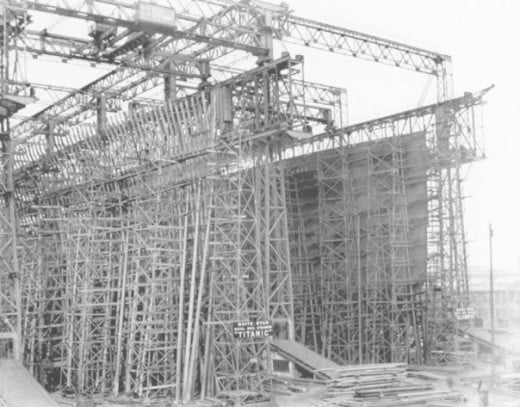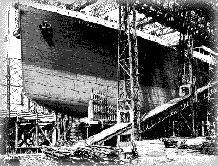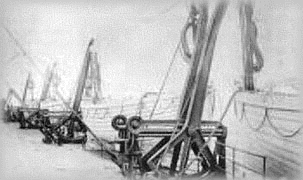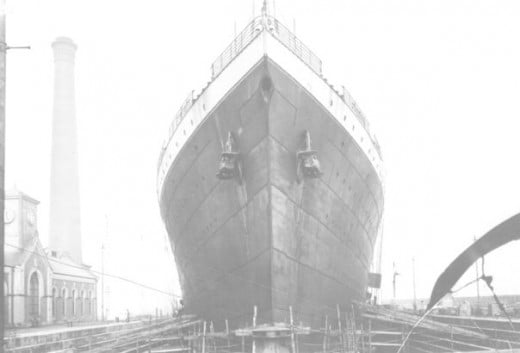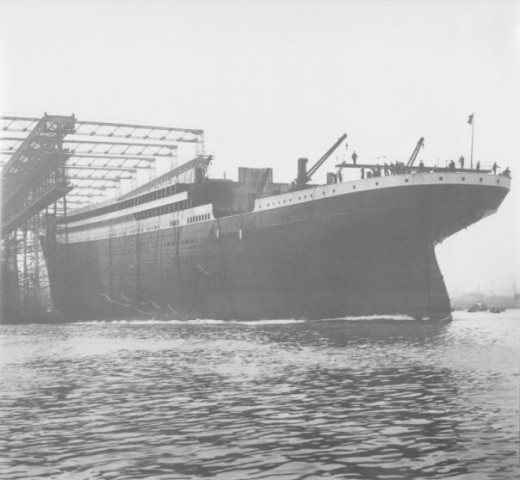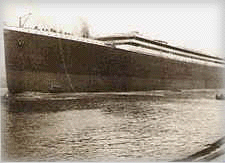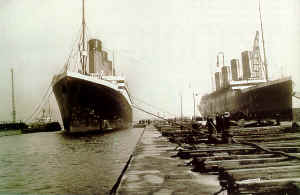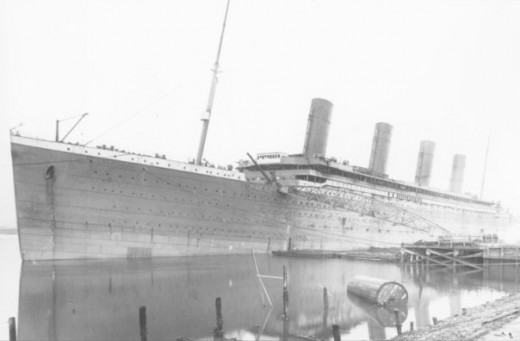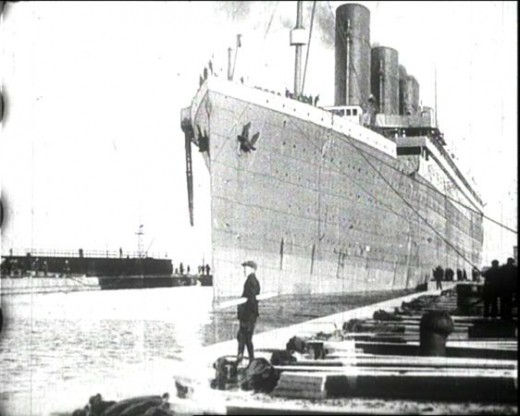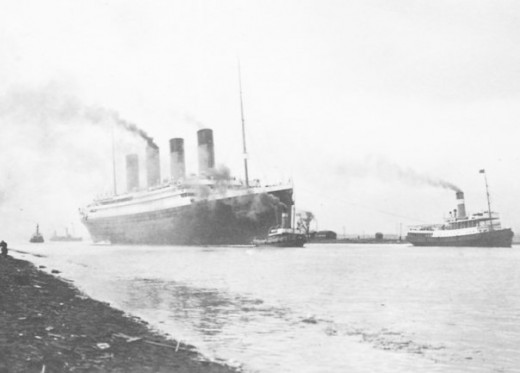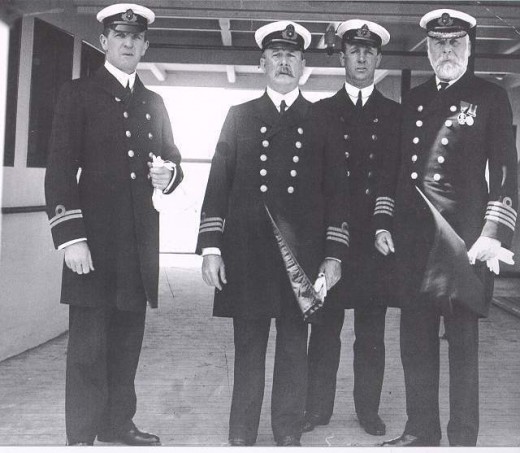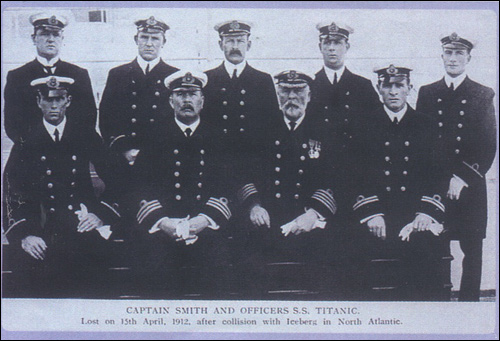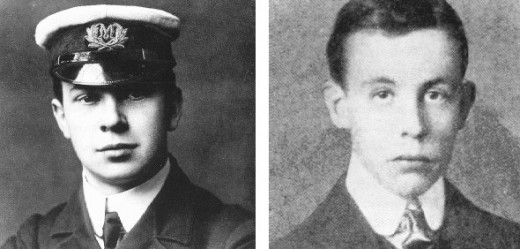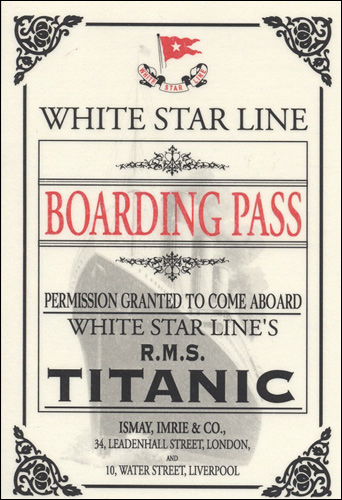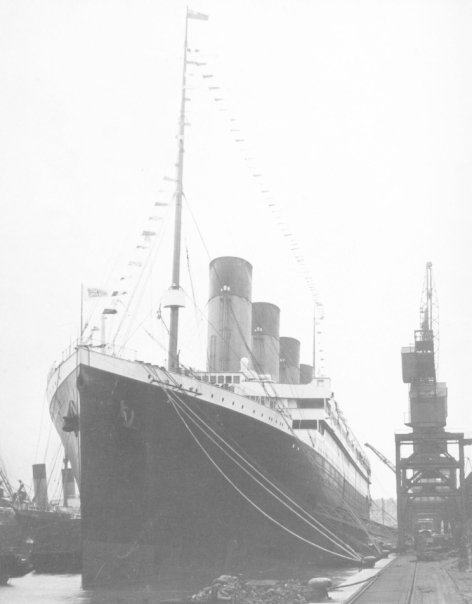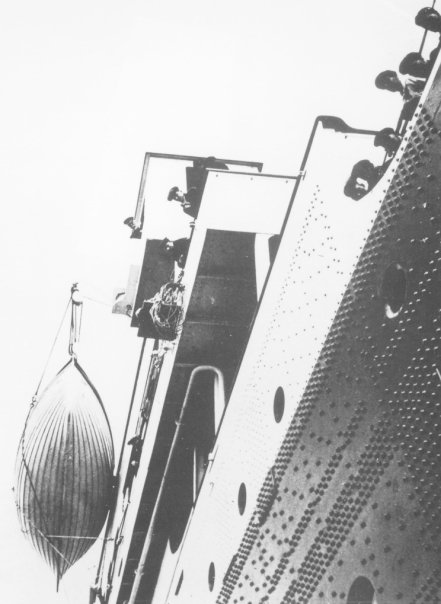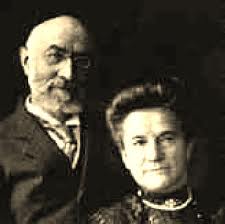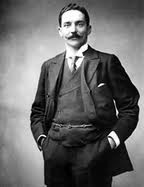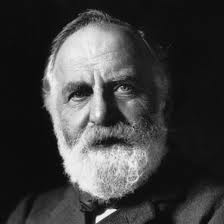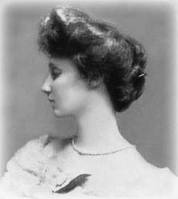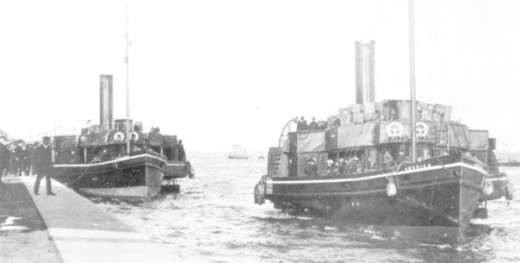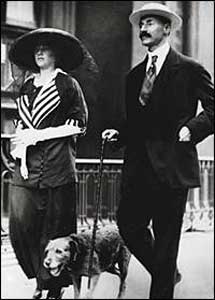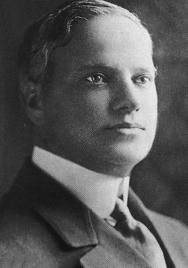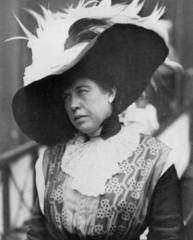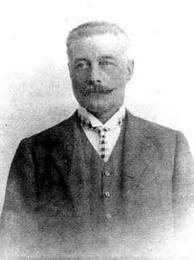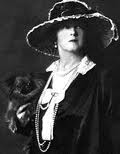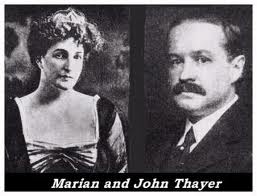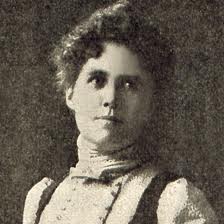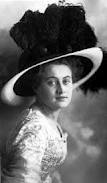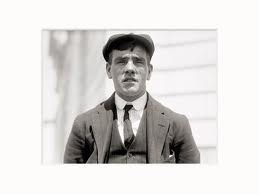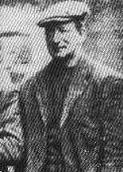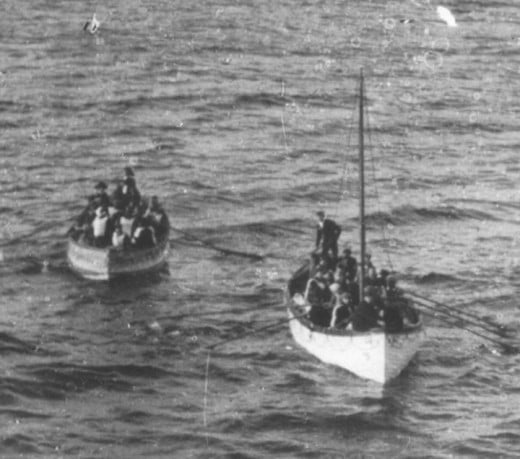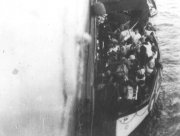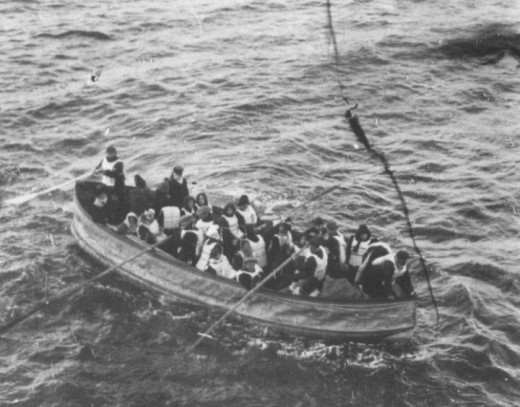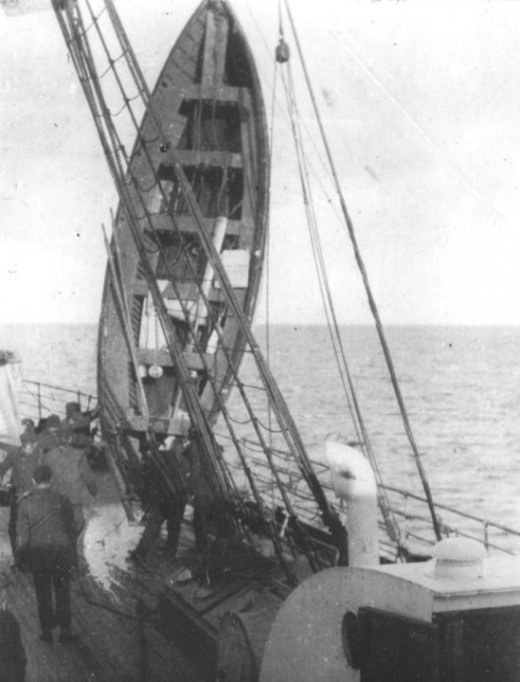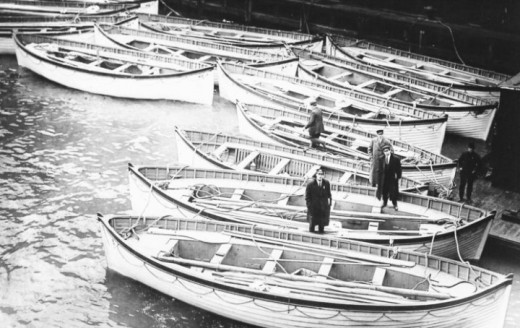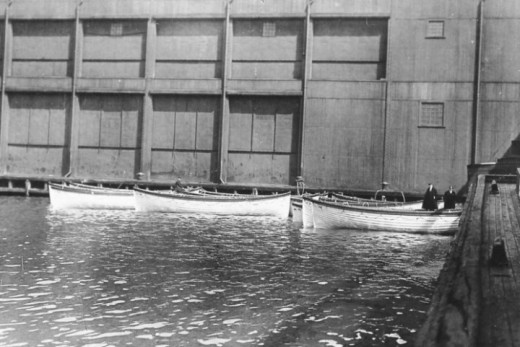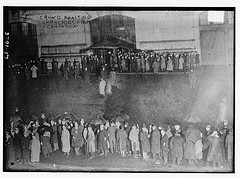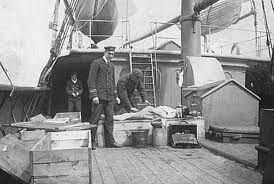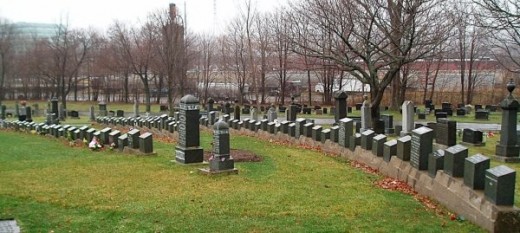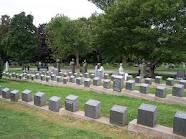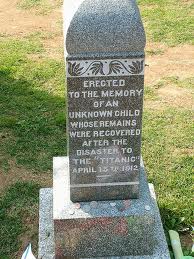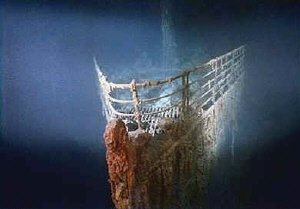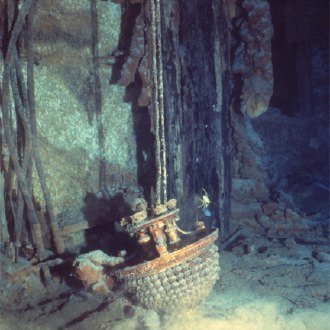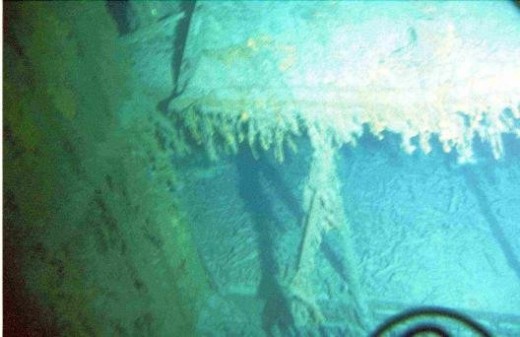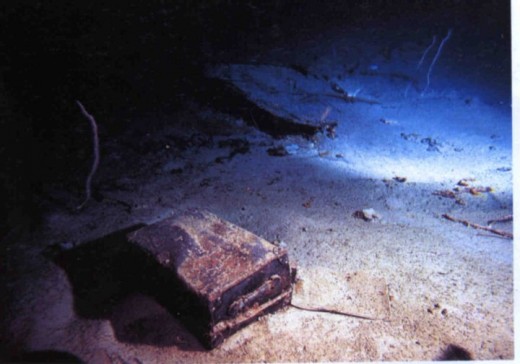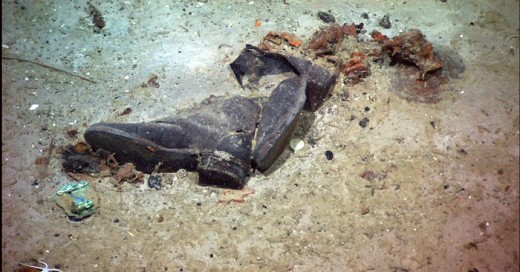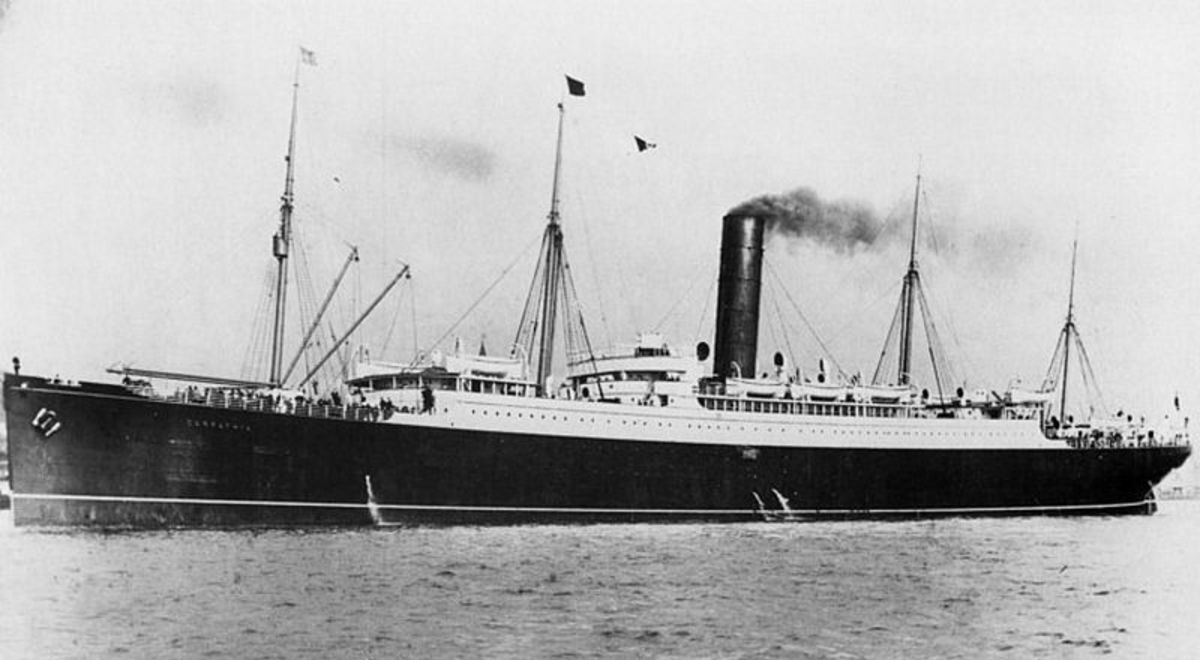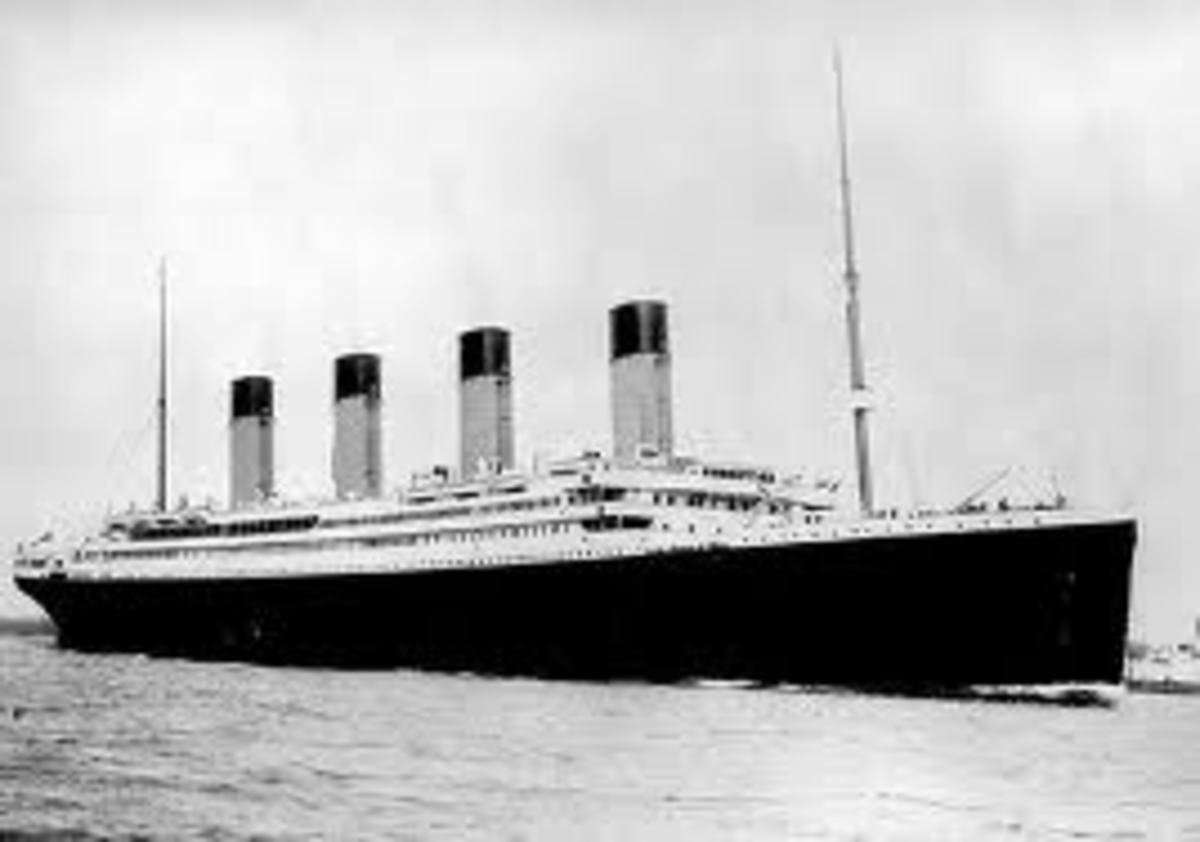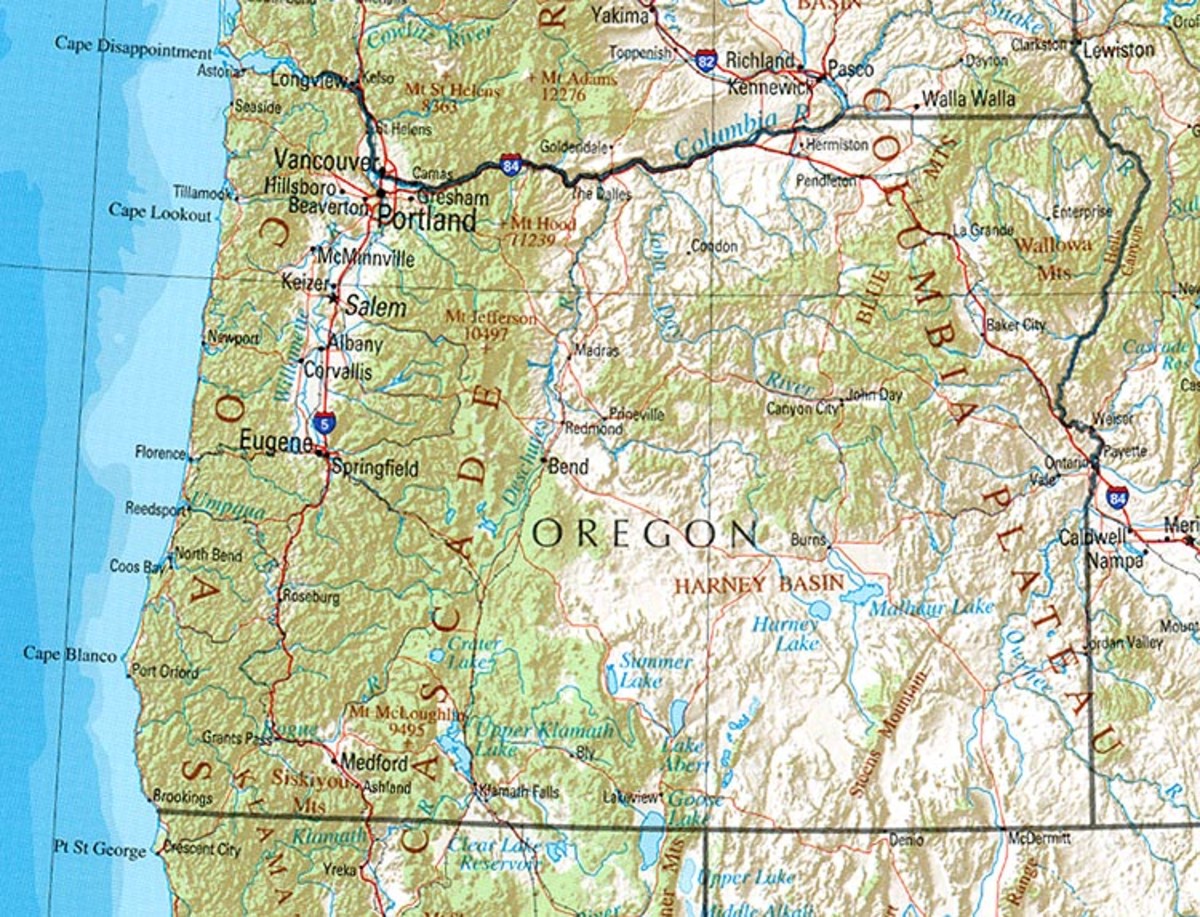WHITE STAR LINE RMS TITANIC




R.M.S Titanic was thee largest steam passenger liner of its era and once called 'unsinkable' by Belfast Shipyard workers from Harland & Wolff Shipbuilding Company whom constructed this Olympic-class steam passenger liner. Construction of R.M.S Olympic and her sistership R.M.S Titanic began. Construction of R.M.S Olympic began on Wednesday 16th December 1908 and construction of R.M.S Titanic beginning the following year on Monday 31st May 1909; the third Olympic-class passenger liner commissioned by White Star Line got under way prior to R.M.S Titanic being completed. H.M.H.S Britannic was to enter service as a Olympic-class steam passenger liner construction on H.M.H.S Britannic started on Thursday 30th November 1911.
R.M.S Olympic was the first of these three Olympic-class ocean liners to be launched on Thursday 20th October 1910, until it was withdrawn from service in 1935. H.M.H.S Britannic was launched on Thursday 26th February 1914, she was launched prior to World War One starting, the ship remained in Harland & Wolff Shipbuilding Company until it was commissioned to become a Hospital Ship on Thursday 23rd December 1915, whilst being used as a hospital ship in KEA an island off Greek, the ship struck a mine in the Kea Channel on Tuesday 21st November 1916 were it sank with the loss of 30 lives. However, R.M.S Olympic and H.M.H.S Britannic are not remembered as well as White Star Line second Olympic-class steam passenger liner R.M.S Titanic.





Background To RMS Titanic
R.M.S Titanic was the second steam passenger leviathan Olympic-class ocean liner. The first leviathan Olympic-class steam passenger ocean liner to be built was R.M.S Olympic was construction beginning Wednesday 16th December 1908. Five months, two weeks and one-day construction of R.M.S Titanic began on 31st May 1909 and 'Gigantic' (renamed HMHS Britannic) was the final leviathan Olympic-class steam passenger ocean liner to be built, construction on the last leviathan Olympic-class ocean liner began on Thursday 30th November 1911. These three leviathan Olympic-class steam passenger ocean liners were to be the largest sea-going vessels in White Star Lines fleet, who by 1912 had 29 steamers and tenders.
By mid-1907 Joseph Bruce Ismay (White Star Line Chairman); Lord W. J. Pirrie (Harland & Wolff Shipbuilding Company Chairman) and John Pierpoint Morgan (American financier, multi-millionaire, who controlled White Star Line's parent corporation International Mercantile Marine Company) cam up with the notion to construct three leviathan Olympic-class steam passenger ocean liners. White Star Line's three leviathan ocean liners would be bigger than their rivals R.M.S Lusitanic and R.M.S Mauretanic (Cunard Line vessels). White Star Line's leviathan vessels were going to be able to transport more cargo, freight and passengers across the North Atlantic Ocean than any other sea-going vessels of their era.
German shipping companies Hamburg America and Norddeutscter Lloyd and Cunard line had just launched R.M.S Lusitania and R.M.S Mauretania, these companies all had the fastest passenger vessels of the era.
However, Joseph Bruce Ismay, Lord W. J. Pirrie and John Pierpoint Morgan's three leviathans were going to concentrate on the luxury of its paying passengers rather than on how fast the liner was going to travel.
Harland & Wolff Shipbuilding Company would automatically get the contracts to construct these three leviathans; due to the fact that they had a long established relationship with White Star Line that dated back to 1867. Harland & Wolff Shipbuilding Companies design department were given a lot of latitude when it came to designing shipping vessels for White Star Line. The usually company policy between Haland & Wolff Shipbuilding Company and White Star Line was that White Star would sketch out their ideas which Harland & Wolff' design departments would then take away and turn it into a ship design.
Harland & Wolff were authorized to spend whatever they thought the leviathans required; cost considerations were relatively low on the agenda. Harland & Wolff were also given an additional 5% profit margin to work with. Int the case of R.M.S Olympic and R.M.S Titanic there was a cost of £3million plus "extras to contract" as well as the 5% profit margin.
Lord W. J. Pirrie as Chairman of Harland & Wolff Shipbuilding Company put the companies leading designers to work on designing these three leviathan Olympic-class steam passenger ocean liners. Lord W. J. Pirrie Chairman of Harland & Wolff Shipbuilding Company was also a director of White Star Line overseen the whole project.
Mr Thomas Andrews Jr, a former naval architect, who was now Managing Director of Harland & Wolff Shipbuilding Companies design department.
Mr Edward Wilding was responsible for calculating the vessels design, stability and trim.
Mr Alexander Carlisle (Lord W. J. Pirrie's brother-in-law) was Harland & Wolff Shipbuilding Companies Chief draftsman and General Manager; his responsibilities for the three leviathans were to include the decorations, equipment and all general arrangements, which did include the implementation of an efficient lifeboat davit design.
Wednesday 29th July 1909 Harland & Wolff Shipbuilding Company presented their designs to Joseph Bruce Ismay and the Executives from White Star Line. Joseph Bruce Ismay approved the designs and two days later signed three 'letters of agreement' authorizing construction to begin on the three leviathans.










Construction Of RMS Titanic
Due to the sheer size of White Star Line's three leviathan Olympic-class steam passenger ocean liners gave Harland & Wolff Shipbuilding Company engineers a major challenge, never in the whole of shipbuilding had vessels of this size been constructed. R.M.S Olympic, R.M.S Titanic and H.M.H.S Britannic were constructed at Queen's Island in Belfast Harbour, which is now known as 'The Titanic Quarter'. In order for Harland & Wolff Shipbuilding Company to be able ton construct these three leviathan Olympic-class steam passenger ocean liners they had to demolish three of their existing slipways, and had to build two new slipways; the biggest ever constructed up to the time to accommodate these leviathans.
Harland & Wolff Shipbuilding Company construction was to facilitate an enormous gantry built by Scottish Civil engineeering firm Sir William Arrol & Co. 'The Arrol Gantry' stood at 228 feet high, 270 feet wide, 840 feet long and weighted more than 6,000 tons. The Arrol Gantry was built to accommodate numerous moblie cranes and a separate floating crane, capable of lifting 200 tons, that was brought in from Germany.
R.M.S Olympic and R.M.S Titanic were virtually constructed parallel to one another. Both leviathans took approximately 26 months to build and were constructed more or less using similar construction process. Originally the vessels were designed essentially as enormous floating box girder, with their keel acting as a backbone with the frames of the hull forming the ribs. At the base of these two leviathans was a double bottom - 5 feet 3inches deep - that supported 300 frames; each between 24 inches and 36 inches apart and measuring up to approximately 66 feet long. They terminated at the B Deck (Bridge Deck ) and were then covered with steel plates that formed the outer skin of the vessel.
There was 2,000 hull plates that were single pieces of rolled steel, most were 6 feet wide and 30 feet long and weighted between 2.5 and 3 tons. The thickness of the steel varied from 1 to 1.5 inches. These steel plates were laid in a clinkered fashion (overlapping) from her keel to bilge. After the bilge the steel plates were then laid in the 'in and out' style, where strake plating was then applied in bands with the gaps being covered by the 'out strakes', overlapping on the edges. These leviathans were held together with approximately 1,200 tons of iron and steel rivets; they were fitted on to these vessels by using an hydraulic machine or they were hammered in by hand.
The construction of these leviathans was dangerous and difficult, for the 1,500 men whom were employed at Harland & Wolff Shipbuilding Company. Safety precautions were rudimentary at best, the majority of the work was dangerous and carried out without any safety equipment such as safety helmets; hard hats; hand guards on machinery; etc. As a result; deaths and injuries were to be expected; whilst R.M.S Titanic was being constructed their was 246 recorded injuries; 28 of which were 'severe' such as an individuals arm being severed by machinery and or an individuals leg(s) being crushed by a falling piece of steel. Six individuals died whilst R.M.S Titanic was being constructed and fitted out; a further two individuals died in the workshop and sheds at the shipyard. Prior to the launch of R.M.S Titanic a piece of wood fell onto a worker and killed him.
On Wednesday 31st May 1911 at 12:15pm at Thompson Dry-Dock, Queens Shipyard in the presence of Lord William J. Pirrie; Joseph Bruce Ismay; John Pierpoint Morgan and 10,000 onlookers R.M.S. Titanic was launched into the Irish Sea. Thompson's Dry-Dock Slip 3 had to be lubricated with rail-road grease; 23 tons of tallow; soft soap and detonators were fired. In keeping with White Star Line traditional policy, R.M.S. Titanic was never christened with champagne or formally named.
R.M.S Titanic was then towed to a fitting out berth where she remained until Tuesday 2nd April 1912 at 6am when her sea trials started with a skeleton crew; her trials were have supposed to been conducted on Monday 1st April 1912 but had to be cancelled due to bad weather conditions . R.M.S Titanic's fitting-out took longer than expected due to Joseph Bruce Ismay changing designs and work was halted when R.M.S Olympic had a collision in September 1911.
Two-weeks prior to R.M.S Titanic's sea-trail, the process for signing-up recruits for her crew began on Saturday 23rd March 1912; some recruits were sent to Belfast, Ireland to serve on the skeleton crew during her sea-trials and voyage to Southampton, England.


RMS Titanic Sea-Trials
R.M.S Titanic began her sea-trials on Tuesday 2nd April 1912 at 6am with her skeleton crew. Her sea-trials had been postponed for a day due too bad weather conditions. For her sea-trials R.M.S Titanic had a skeleton crew; 41 crew members, 78 firemen, greasers and stokers; plus various representatives from travel companies; Thomas Andrews and Edward Wilding (Harland & Wolff Shipbuilding Company); A. Sanderson(International Mercantile Marine Trust). However, Joseph Bruce Imsay and Lord William J. Pirrie with too ill to be present.
Marconi radio-operators Harold Bride and Jack Phillips were also onboard to fine-tune the radio equipment.
Mr Francis Carruthers, a surveyor from 'The Board Of Trade' was also onboard to make sure everything on R.M.S Titanic was working properly and was sea-worthy to carry passengers.
Over the next 24-hours R.M.S Titanic was driven at various speeds, made to do a 'Crash Stop' where her engines were reversed full ahead to full stern; stop within 850 yards or 3 minutes 15 seconds. R.M.S Titanic covered approximately 80 nautical miles, averaging 18 knots and reaching a maximum speed of just under 21 knots.
At 7pm on Wednesday 3rd April 1912 on her return to Belfast Mr Carruthers Board of Trade Surveyor signed R.M.S Titanic's 'Agreement and Account of Voyages and Crew" declaring her seaworthiness for one-year.
At 8pm on Wednesday 3rd April 1912 R.M.S Titanic left Belfast (for the very last time) and headed the 570 nautical miles to Southampton. On Thursday 4th April 1912 at midnight R.M.S Titanic was towed into Berth 44 to away the arrival of the remainder of her crew and passengers.




RMS Titanic Crew
When R.M.S. Titanic sailed from Belfast, Ireland to Southampton, England she only had a skeleton crew. The remainder of her crew would board the leviathan luxury class steam passenger liner over the next six-days whilst she was waiting to leave Southampton, England.
- R.M.S Titanic had 23 Female crew members - 20 Stewardesses (Waitresses, Maids Attendants; their duties were very similar to the Male Stewards, but the Stewardesses would normally only serve the female passengers)
- Two Cashiers
- 'Matron'
Just over Ninety-Seven per cent of R.M.S Titanic's crew were male -
- Captain Edward John Smith whom had Seven Officers underneath him.
- R.M.S Titanic has Twenty-Nine Able-Bodied Seamen
- Two Boatswain Mates
- One Master-at-Arms whom had an assistant
- Seven Quartermasters
- Six Mess-Hall Stewards
- Six Lookouts
Engineering Crew comprised of -
- Thirteen Leading Firemen (Stoker Foremen)
- One-hundred and Three Firemen (stokers)
- Seventy-three Trimmers (Coal Trimmers)
- Thirty-three Greasers
Victualling Crew totalling 398 -
- Two-hundred and ninety-nine Stewards
- Bath Stewards
- Bedroom Stewards
- Glory-hole Stewards
- Linen Steward
Sixty-two men were employed as Galley and Kitchen Staff
Four Clerks were employed in the Purser's Office so that they could deal with Passenger's enquiries and requests.
Restaurant Staff - A. P. Luigi Gatti owned R.M.S. Titanic's A` La Carte Restuarnt whom employed Sixty-six people.
Guarantee Group There was nine members of the Guarantee Group who were given passenger accommodation, they were regarded thought as being members of the crew. The Head of the Guarantee Group was Thomas Andrews who had also been Construction Manager and Head of Harland & Wolff Shipbuilding Company's Design Department; the rest of the group comprised of three fitters, joiner; draughtsman ; plumber; electrician and his apprentice. The Guarantee Group members were on R.M.S. Titanic's maiden voyage to oversee any unfinished work or to find and fix any problems that may arise during her voyage.
R. M. S. Titanic's Orchestra All of the Eight Orchestra members travelled on R.M.S. Titanic as second-class passengers. Like A. P. Luigi Gatti's staff the orchestra members were not on White Star Line's payroll. These eight men never performed as an eight-man orchestra , but would always performing as two-separate orchestra's comprising of four-men in each orchestra.







Wednesday 10th April 1912
For RMS Titanic's maiden voyage there was approximately 1,317 passengers
- 324 First-Class
- 284 Second Class
- 709 Third-Class
RMS Titanic was not full to capacity for her maiden voyage considering she could accommodate
- 1,034 First-Class
- 510 Second -Class
- 1,022 Third-Class
Passengers started to arrive from 9:30am when London and South Western Railways Boat Train that left Waterloo Road, London arrived at Southampton Terminus Railway Station on the quayside, right beside where R.M.S. Titanic was docked.
Third-Class Passengers were boarded onto RMS Titanic first; due to their sheer numbers prior to being boarded they were inspected for any ailments and physical impairments that could lead to them being refused entry into America - it was not a prospect that White Star Line wanted to see, as it meant they would have to carry them back across the North Atlantic Ocean. One such family to travel Third-Class and undergo such inspections were the Dean's family whom had decided to leave England and immigrate to Wichita, Kansas.
First-Class Passengers such as the most prominent people in society had booked passage on R.M.S. Titanic and would have been shown to their stateroom or suite by stewards and would have been greeted personally by Captain Edward John Smith
Some prominent First-Class passengers boarding R.M.S Titanic at Southampton were -
- Co-owner of Macey's Department Stores Mr Isidor Straus and his wife Ida
- White Star Line's Managing Director Joseph Bruce Ismay
- Journalist and social reformer William Thomas Stead
- Author Jacques Futrelle and his wife Mary
- The Right Honourable The Countess of Rothes Lucy Noel Martha Leslie; her parents Thomas and Clementia Dyer-Edwards; Cousin Gladys Cherry and maid Roberta Maioni.
- Belgian's Emma Duyvejonck and Henri Van De Steen were not allowed to R.M.S Titanic










Wednesday 10th April 1912
R.M.S Titanic was scheduled to depart from Southampton at noon. However, disaster nearly occurred when she passed S.S City of New York and R.M.S Oceanic moored liners. Due to R.M.S Titanic's huge displacement she caused these moored liners to be lifted by the bulge of water, then to drop into a trough. The S.S City of New York mooring cables were unable to take the sudden strain and snapped, swinging her stern round to R.M.S Titanic. The Vulcan, a tugboat came to S.S City of New York's aid by taking her undertow. S.S City of New York and R.M.S Oceanic avoided collusion with RMS Titanic by approximately four feet. The incident delayed RMS Titanic's maiden voyage by approximately one hour; whilst The Vulcan brought the drifting SS City of New York under control. After Captain Smith ordered R.M.S Titanic's engines to 'full stern'.
After making it safely through the complex of tides and channels of Southampton's waters and the solent R.M.S Titanic headed out into the English Channel, for the 77 nautical mile journey to Cherbourg, France.
R.M.S Titanic arrived at Cherbourg, France at 18:30 on Wednesday 10th April 1912. However due to the sheer size of R.M.S. Titanic she was unable to actually dock at Cherbourg dock's; therefore tenders had to be used to allow passengers to disembark the liner, such as Thomas and Clementia Dyer-Edwards.
Tenders were used to allow the 274 passengers to board the luxury liner. Some prominent people within society boarded R.M.S Titanic at Cherbourg, France
- Colonel John Jacob Astor IV (an American Millionaire), his Wife Madeleine (whom was five-months pregnant); their valet Victor Robbins, maid Rosalie, nurse Caroline Endres and the family dog Kitty
- Industrialist Mr Benjamin Guggenheim, who had originally booked to travel on R.M.S Lusitania who was undergoing repair work. However, Mr Guggenheim decided to transfer his tickets from R.M.S Lustanis replacement The Carmania to R.M.S Titanic. Travelling with Mr Benjamin Guggenhein and his Valet Victor Giglio were booking into a stateroom cabin. Mr Guggenheim's mistress French singer Madame Leontine Aubart and her maid Emma Sagesser occupied another stateroom. Whilst Mr Guggenheim's chauffeur Rene Perriot travelled second-class.
- Activist, American Socialite and Philanthropist Margaret 'Molly' Brown
- Sir Cosmo Edmund Duff-Gordon (5th Baronet Deputy Lieutenant), his wife Lady Lucy Duff-Gordon (London fashion designer 'Madame Luclie') and his secretary Laura Mabel Francatelli
- Cricketer and businessman John Borland Thayer and his wife Marian were in one cabin C-68, whilst their 17-year-old son Jack was in cabin C-70
- Author and socialite Helen Churchill Candee
- Silent film actress Dorothy Gibson
The whole disembarking and embarking of R.M.S Titanic at Cherbourg, France took 90 minutes to complete.
Two and a half hours later R.M.S Titanic weighted anchor and left Cherbourg, France for the fifteen and a half hours journey to Queenstown, Ireland.
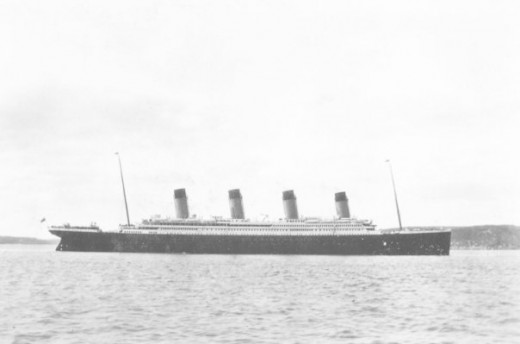
Thursday 11th April 1912
On Thursday 11th April 1912 R.M.S Titanic arrived at Queenstown, Ireland at 11:30am. However, she faced the same problems as she had done the previous day at Cherbourg, France. Queenstown's docking facilities were totally unsuitable for the sheer size of R.M.S Titanic. Like in Cherbourg, France tenders were used to ferry the seven passengers whom left the liner and Queentown's native White Star Line stoker John Coffey (whom decided to unofficially leave the liner by hiding under the mail bags that were being transported tor shore). Father Francis Browne (A Jesuit trainee) also left the liner, he was a very keen photographer and whilst onboard R.M.S Titanic took lots of photographs, which included the last known photograph of the luxury liner.
Tenders at Queenstown, Ireland ferried 113 third-class passengers and seven second-class passengers to board R.M.S Titanic.
R.M.S Titanic weighted anchor and left Queenstown, Ireland at 13:30 for the last time to make the journey westward across the North Atlantic Ocean to New York City, United States of America.
Friday 12th April 1912
By mid-day on Friday 12th April 1912 R.M.S Titanic had sailed through calm waters approximately 484 nautical miles since leaving Queenstown, Ireland.
Saturday 13th April 1912
By mid-day on Saturday 13th April 1912 R.M.S Titanic had sailed through calm waters approximately another 519 nautical miles. R.M.S Titanic Marconi radio operators Harold Bride and Jacks Phillips received an iceberg warning from the Rappahannock of a heavy ice field. Rappahannock message the R.M.S Titanic read that they had 'just passed through heavy ice field and several icebergs'. R.M.S Titanic Marconi radio operators Bride and Phillips acknowledged the message saying they had received it.


Sunday 14th April 1912
Bride and Philips received iceberg warning throughout the day staring at 9am when they received a message from R.M.S Caronia warning of an icefield with icebergs at 42oN from 49o to 51o.
One hour fifteen minutes later Captain Smith was given the first radio message warning of a heavy field of icebergs.
R.M.S Titanic was due to have a lifeboat drill at 11am. However, Captain Smith cancelled the drill without giving an explanation as to why. Some historians believe the reason behind the lifeboat drill been cancelled was to allow the passengers whom wanted to attend church services could do so. Thus R.M.S Titanic's crew were unrehearsed for when the lifeboat evacuation commenced later that night.
R.M.S Titanic received their second iceberg warning from the S.S. Noordam reporting that their was 'much ice' in the same area as R.M.S Caronia had reported at 9am.
At mid-day Marconi radio operator Jack Phillips receives a third radio message. This time is was from the S.S. Baltic, who reports large icebergs in the area ahead of R.M.S Titanic - 42oN 51O 31OW. At exactly the same time R.M.S Titanic's Ships Officers gathered on the Wing Bridge to calculate her position.
R.M.S Titanic Marconi radio operators Bride and Phillips receive a message from The Amerika reporting 'large icebergs' in the vicinity or near to 41o 27oN 50'8' West at 1:45pm.
Fifteen minutes later Captain Smith receives the iceberg warning and passes them to Joseph Bruce Ismay.
Between 5:30pm and 7:30pm the air temperature outside R.M.S. Titanic plummented to 33of (0.5oc).
At 5:50pm R.M.S Titanic's Captain Smith altered her sailing course slightly to South and West of the usual sailing route. This had originally been planned to occur at 5:30pm but had been delayed by 20 minutes to allow R.M.S Titanic to travel further South in an attempt to avoid the ice region where the ice-fields were being reported. This change of sailing course should have directed R.M.S Titanic into the area of any gulf stream that should have been clear of any icebergs. any other year the gulf stream would have been free of icebergs, but not in 1912. In 1912 the ice-cold water had pushed the warm gulf stream further south - thus the change of direction actually put R.M.S. Titanic on a collision course with the fatal iceberg.
Ten minutes later Chief Officer Henry Tingle Wilde was relieved of his duties on R.M.S Titanic's bridge by second officer Charles Lighter.
First Officer William Murdoch ordered that R.M.S Titanic's Forecastle hatch was to be closed at 7:15pm as the glow from the hatch was interfering with the Lookouts watch up in the crow's nest.
Marconi assistant radio wireless operator Harold Bride was finishing work on the accounts at 7:20pm and finally picked up the iceberg warning messages sent from S.S. Californian warning of three large icebergs in the vicinity of 42o 3o N, 49O 9O W. These messages were passed to Second Officer Charles Lightoller who was on duty at the time in the ship's bridge.
Whilst Captain Smith was attending a dinner party in the first-class dining room at 7:30pm. The Marconi wireless radio operator Phillips received a radio message from S.S Antillian saying that at 6:30pm there was three large icebergs five miles ahead of them to the south.
Second officer Charles Lightoller informs all of the crew on R.M.S Titanic at 8:40pm to keep a watch on the liners fresh water supply due to the sea water surrounding the liner plummenting to near freezing.
Captain Smith leaves the dinner party at 8:55pm. However, prior to going to his cabin for the night he checks-in with Second Officer Lightoller in the bridge house. The conditions outside were clear, flat calm and moon-less. due to the lack of wind and the ocean being calm spotting icebergs would have been difficult for the liner's lookouts. Without wind the lookouts would have been unable to see the ocean water breaking onto the iceberg. The lack of moonlight would have not helped either as it limited the chance of reflective light from the iceberg.
Captain Smith retired to his cabin at 9:20pm for the night, leaving Second Officer Ligtholler with orders for him to be woken "if it becomes at all doubtful".
Ten minutes later S.S. Mesaba wireless operator Stanley Adams sent a message to all eastbound vessels including R.M.S Titanic saying that they had just seen a heavy ice pack and numerous large icebergs plus a field of ice; their weather was good and clear. At the same ime Second Officer Lightoller advised the two lookouts to watch carefully for icebergs till dawn. Five minutes later Phillips let Adams know that he had received the message. three minutes later Adams sent another message saying 'stand by'. Adams was waiting on Phillips to indicate that Captain Smith had been given the iceberg warning message. However, Phillips did not reply back to Adam; he just continued to sent passenger message to Cape Race, Newfoundland.
First Officer Murdoch relives Second Officer Lightoller at 10pm from the bridge house. At the same Lookouts Frederick Fleet and Reginald Lee began their shift in the crow's nest. First Officer Murdoch informed Fleet and Lee to watch carefully for icebergs till dawn.
At approximately 10:55pm The S.S. Californian stopped between 10 to 15 miles North of R.M.S. Titanic. S.S Californian wireless radio operator Cyril Evans sent a message out to all vessels in the are saying that they had to stop due to an ice-field and were caught up in it. Phillips did receive the message from Evans. Phillips did reply to Evans at 11:10pm telling him to shut up as he was busy working with Cape Race. Evans remained at his post until 11:30pm when he retired to his bed at the same time. lookouts Fleet and Lee saw a slight haze appear directly ahead of R.M.S Titanic
Ten Minutes later; 11:40pm R.M.S Titanic travelling at less then21 knots; when suddenly the liner's lookouts Fleet and Lee spot the fatl iceberg approximately 500 yards ahead of the luxury liner. Fleet and Lee immediately sounded the warning bell by ringing it three times; Fleet then phoned the Bridge House with the message 'iceberg right ahead'.
Upon hearing the message First Officer Murdoch called to the helmsmen to turn R.M.S Titanic's ship-wheel to 'hard-a-starboard'; whilst phoning the engine room at the same time to stop the liners engines and then to put them to full astern; whilst activating the watertight doors. A few seconds later R.M.S Titanic started to veer to port. However, it was too little too late R.M.S Titanic's starboard side had made direct contact with the iceberg.
Ten minutes late 11:50pm) the first five water tight compartments of R.M.S Titanic had started to take in water. Whilst the water had risen above 14-feet above the forward keel.
By midnight Captain Smith had been informed of the situation regarding R.M.S Titanic and was now in the Bridge House where reports of damage to various parts of R.M.S Titanic began to arrive -Senior officers; J. Hutchinson (Carpenter) and Thomas Andrew (Construction Manager and Head of Harland & Wolff Shipbuilding Company's Design Department) informed Captain Smith that the luxury leviathan would sink. Thomas Andrews calculated that the liner would be afloat for 'a few hours'.




Monday 15th April 1912 timeline
By 12:05am Captain Smith had give the ships crew orders to start uncovering the standard lifeboats and to get the passengers ready and assemblyy them on the ship's deck. However, there was only enough room in the lifeboats to caryy 1,178 of the estimated 2,229 Passengers and crew whom were on-board R.M.S Titanic for her maiden voyage. By now the liner's Squash Court was awash with water.
Ten Minutes later (12:15am) Captain Smith gave Marconi wireless radio operators Bride and Phillips orders to start sending out distress calls. The distress call was to any vessel and read 'CQD Titanic 41.44 N 50.24 W'. Two minutes later they sent out another message to any vessel stating the same but adding that the liner required immediate assistance. The only two vessels to respond to R.M.S Titanic's distress calls was S.S Frankfurt (whom was 170 miles away) and her sister ship R.M.S Olympic (approximately 500 miles away). Whilst Captain Smith was giving the orders to Bride and Phillips the liners Orchestra started to play in the First-Class lounge.
At 12:20am Captain Smith gave the orders to the ships crew to start loading the standard lifeboats with women and children only. R.M.S Titanic's Seamans' Quarters were now 48-feet above her keel on E Deck which were now flooded. Bride an Phillips sent another message to R.M.S Carpathia's radio operator Harold Thomas Cottom that they needed assistance at once as they had struck an iceberg and gave the position of the ships. One minute later Cotton replied saying that their was a batch of messages coming through from them from Cape Cod. Bride and Phillips respond was 'CQD CQD'. Even through R.M.S Carpathia was approximately 58-miles away (a 4-hour journey) Cottom asked Bride and Phillips if he should inform R.M.S Carpthia's Captain Arthur Henry Rostron that R.M.S Titanic was in difficulty and required assistance. Bride and Phillips replied 'yes and come quick'. Eight minutes later Bride and Phillips got a reply from R.M.S Carpathis Cottom saying that they were 'putting about and heading' towards R.M.S Titanic. eight minutes late Bride and Phillips replied to Cottom to inform him that the luxury liner was sinking by her head and that they were all going down.
Two minutes later (12:45 am) the first of R.M.S Titanic's standard lifeboat No. 7, which was situated on the liners starboard side was launched. However standard lifeboat No. 7 was not filled to capacity (65 passengers); she only had 28 passengers. R.M.S Titanic's Fourth Officer Joseph Groves Boxall was sure he was seeing a vessel approaching them, which then disappears. Boxall tried to contact the vessel by using R.M.S Titanic's Morse lamp. The first of R.M.S Titanic's eight emergency distress rockets were released by Quartermaster George Rowe. At the same time Bride and Phillips received a message from R.M.S Titanic's sister-ship whom was en-route to England (500 miles away travelling in the opposite direction) . Bride joked with Phillips when he sent the 'S.S.O' message to R.M.S Olympic saying he may never get to sent the new distress signal again.
R.M.S Celtic picked up a message sent from R.M.S Titanic at 12:50am stating that they required immediate assistance and her position. Three minutes later the R.M.S Caronia sent a message to R.M.S Baltic saying that R.M.S titanic required immediate assistance and gave them the position.
RMS Titanic Standard Lifeboat No. 6 was lowered into the North Atlantic Ocean. This lifeboat was situated on the liner's Port-side. Stand lifeboat No. 6 again was not filled to capacity (65 passengers) again it left the liner with 28 passengers on it, which included Major Arthur Godfrey Peunchen and Margaret Brown. Standard Lifeboat No. 5 was lowered from the Starboard side. Joseph Bruce Ismay was warned by Fifth Officer Harold Godfrey Lowe to stop interfering with his commands.
Standard Lifeboat No. 3 was lowered into the North Atlantic Ocean from the Starboard side at 1am carrying 11 crew members and 22 passengers making a total of 33 passengers. At the same time Bride and Phillips sent out another distress signal. 'The Cininatti' radio operator replies;Bride an Phillips messages saying that they do not require assistance as her sister-ship R.M.S Olympic had answered her distress call. Bride and Phillips sents a message to R.M.S Olympic giving them there position and informing that they the liner has struck an iceberg. Two minutes later Bride and Phillips made contact withR.M.S Empress of Asia saying that they required immediate assistance. Two minutes late 'The Virginian' radio operator tries to sent R.M.S Titanic a message but gets no reply. Cape Race informs The Virginian radio operator to tell his Captain that R.M.S Titanic has hit an iceberg and they require immediate assistance.
Star-board Standard Lifeboat No. 1 was lowered into the North Atlantic Ocean a 1:10am, the lifeboat was carrying 7 crew members and 12 passengers including Sir Cosmo Duff-Gordon and his wife Lady Lucy Duff-Gordon. Standard lifeboat no. 8 from the port-side carrying 39 passengers including Lucy Noel Martha Leslie (The Countess of Rothes) who steered the lifeboat for the rest of the night Bride and Phillips were still messaging R.M.S Olympic saying that they had struck an iceberg and that the vessel was sinking head first asking them to give assistance as soon as possible with their position. Another message passed between the sister-ships with R.M.S Olympic saying that they should get their boats ready and how far away from R.M.S Titanic they were
By 1:15am the North Atlantic Ocean icy cold water had reached R.M.S Titanic's name on her bow, her list was now slightly to the vessels port-side. R.M.S Titanic's lifeboats were now leaving with more than 28 passengers on-board. R.M.S Baltic sent a message to R.M.S Caronia to inform R.M.S Titanic that they were sailing towards her to give assistance.
Five minutes later (1:20am) Star-board Standard life boat No.9 left the line. R.M.S Titanic had now developed a significant list on her startboard side. 'The Virginian' overheard Cape Race tell R.M.S Titanic that they were going to their assistance and give their position as they were 170 miles north of the sinking liner.
Standard lifeboat No. 12 left with deck Crew members Mr Ferderick Clench and Mr John Thomas Poingdestre whom were in charge of 40 children and women was lowered from the vessels port-side at 1:25am. Two minutes later R.M.S Olympic sent a message giving them their position and then asks Bride and Phillips if R.M.S. Titanic was steering southerly to meet them; Bride and Phillips replied saying that they were not putting women and children into lifeboats.
As standard lifeboat No.14 was being lowered from the liner's port-side there was signs of panic animist the passengers whom had gathered there. When lifeboat no. 14 left with Fifth Officer Harold Godfrey Lowe in charge of the 60 passengers whom were in the lifeboat at 1:30am. prior to being lowered into the North Atlantic Ocean Fifth Officer Lowe had fired shots into the air to ward off those passengers whom may have considered rushing for the lifeboat. By this time Bride and Phillips messages to other vessels were now becoming more and more desperate such as their message to their sister-ship stating that 'women and children were being out into lifeboats and that they did not think R.M.S Titanic would stay afloat much longer'.
By 1:35 am four lifeboats had been filled. However,whilst lowering this lifeboats there was nearly a collision with the two on the port-side and the two on the star-board side. First lifeboat to be lowered on the port-side was No. 16 which had 50 passengers on-board. at the same time lifeboat No. 13 carrying 64 passengers (mainly second and third-class) left the vessel. On the star-board side lifeboat No. 14 had been lowered into the North Atlantic ocean; however, seconds later Lifeboat No. 15 had started to be lowered carrying 50 passengers. The passengers in Lifeboat No. 13 could touch the bottom of Lifeboat no 15, but did manage to get to safety in time. At the same time R.M.S Olympic was message Bride and Phillips asking what there weather conditions were like. R.M.S Baltic overhears Bride and Phillips satin that the engine rooms are now flooded. S.S Mount Temple hears S.S. Frankfurt asking if there was any vessels around R.M.S Titanic yet, but there was no respond. Two minutes later R.M.S Baltic messages Bride and Phillips to let them know that they are coming to their aid.
By 1:40am the vast majority of lifeboats had left the sinking liner Englehardt Collapsible lifeboat c was departing when R.M.S Titanic owner Joseph Bruce Ismay saw a chance and jumped into the lifeboat. Those passengers whom were still on R.M.S Titanic had now started moving towards her stern. The last lifeboat on the star-board side was lowered. The North Atlantic ocean was now awash on the liner's deck. Whilst all of this was going on above deck, Bride and Phillips were still receiving and senting radio messages from R.M.S Olympic whom informed them that they were lighting all off their boilers to gain more speed so that they could sail faster to R.M.S Titanic. At the same time Cape Race informed 'The Virginian' that although R.M.S Olympic was on-route they were actually closer to assist. Cape Race only heard R.M.S Olympic respond to R.M.S Titanic's distress calls.
Standard lifeboat no. 2 leaves with 25 passengers on-board from the port-side at 1:45am. Bride and Phillips sent their last message to R.M.S Carpathia asking for assistance as quickly as possible as their engine rooms had now filled right up to the boilers. At the same time S.S Frankfurt sent a message to R.M.S Titanic, which S.S. Mount Temple overhears; S.S Frankfurt gets no respond.
R.M.S Caronia radio operator is sure he hears an unreadable signal from R.M.S Titanic at 1:47am. one minute late R.M.S Empress of Asia hears S.O.S. from R.M.S Titanic to which she replies, but does not receive a message back. S.S. Frankfurt messages R.M.S Titanic to ask what is wrong with the vessel they do receive a reply saying the are fools and to keep out. R.M.S Caronia radio operator overhears S.S Frankfurt working with R.M.S Titanic; according to positions S.S. Frankfurt was approximately 172 miles away from R.M.S Titanic when Bride and Phillips first sent out their distress message for assistance.
Standard lifeboat No. 4 was being loaded on the liner's port-side by 1:55am. the lifeboat was carrying 40 passengers (Women, children and crew), including Madeleine Talmage Astor. Although the lifeboat had 20 empty spaces Mrs Astor husband John Jacob Astor was refused entry onto the lifeboat by Second Office Lightoller, Cape Race messaged 'The Virginian' to say that there had been no communication from R.M.S Titanic for approximately 30 minutes.
By 2am the North Atlantic Ocean's freezing cold water was merely 10-feet below the liner's promenade deck. 'The Virginian' is sure that they heard R.M.S Titanic trying to sent message, but they were very faint due to the vessel losing power.
By 2:05am there was only one lifeboat left R.M.S Titanic Englehardt Collapsible D, which when full to capacity could carry 47 passengers. It left carrying 3 crew members and 44 women and children. Second Officer Lightoller fired his pistol into the air and then formed a human ring around the final lifeboat to leave to prevent it being overcome with passengers. R.M.S Titanic's Forecastle head was now merged in the North Atlantic Ocean and the angle of her decks were becoming more steeper by the second.
Marconi Chief wireless radio operator Jack Phillips and his assistant Harold Bride remained at their post until 2:17am when Captain Smith relives them from their duties by announcing that it was 'every man for themselves'. 'The Virginian' radio operator is sure he overheard R.M.S Titanic senting 'CQ'. Phillips intended to sent the mess 'C.Q.D, D.E. M.G.Y'. However, due to the liner losing power to the radio room the messages were broken up. After Captain Smith relives bride and Phillips from their post, they both climb onto the roff of the Officers' Quarters and also helped launch Englehardt Collapsible lifeboat B. 'The Virginian' radio operator messages R.M.S. Titanic suggesting that they try the emergency setting on the Marconi radio; but they never got a response.
R.M.S Titanic's bow was now starting to plunge into the North Atlantic Ocean and allowing those passengers whom were trapped in Englehardt Collapsible Lifeboat B to break free from R.M.S Titanic, although the lifeboat was turned upside down.
Second-Class passenger Father Thomas Roussel Daivds Bytes hears confessions from 100 First and Second class passengers whom were at the liners Deck-aft end; Father Bytes also gave these passengers absolution. Some point between 12:15am and 2:17 am The Orchestra had moved from the First-Class Lounge onto the deck where they continued to play upbeat music until 2:17am.
Construction Manager and Head of Harland & Wolff Shipbuilding Company Design Department Thomas Andrews was seen smoking in the First-Class lounge.
The vast majority of her crew and passengers felt that they had no other option but to jump into the North Atlantic -2oc Ocean water. However, the vast majority of those who had jumped into the freezing cold ocean did not died of hypothermia; but died when on of the forward funnel's collapsed and crushed them.
Englehardt Collapsible lifeboat A managed to float away safely, with approximately 20 or more individuals holding onto its sides.
All of the leviathans liner heavy machinery started to move towards the bow of the vessel, making a huge roar. The electricity on the luxury liner blinked on and off then went out completely. At 2:18am her broken off stern section settled back into the North Atlantic ocean where it became level for a few moments. Although throughout this time the broken off stern section was filling with water all the time; with the stern section rising every higher into the night sky, prior to sinking slowly to the ocean bed in the North Atlantic ocean.
Survivors from R.M.S Titanic whom were in the -2oc waters were struggling to remain alive in the freezing temperature. within approximately 15 minutes these survivors in the water would have been feeling disorientated, exhausted and then they would likely become unconscious. Between 15 to 45 minutes later those passengers whom were still alive would have hypothermia setting in and then death.
'The Virginian' radioed messaged R.M.S Olympic to see if they had heard anything from R.M.S Titanic at 2:20am, which is the official time given for R.M.S. Titanic's sinking. Fifteen minutes late S.S. Mount Temple hears R.M.S Carpathia's radio operator saying if they are there they are firing rockets into the air. Five minutes later R.M.S Carpathia tried to radio message R.M.S Titanic again. At 2:58am S.S. Birma's radio operator is sure he can hear a message being sent from R.M.S Titanic so sents a message saying that they hope everyone is safe and that they would be arriving at 6a. as they were now only 50 miles away from them.
R.M.S Carpathia tried to message R.M.S Titanic at 3am to sy they are 30-miles away from where R.M.S Titanic sank.
Two minutes later prior to survivors seeing rockets from R.M.S Carpathia; Fench liner 'La Provence messaged R.M.S Celtic to say that no vessel had heard anything from R.M.S Titanic for approxiamtely 2-hours.
Whilst those in R.M.S Titanic's lifeboats waited for help to arrive some of the surviving crew members wanted to return to see if they could find any-more survivors. Third Officer Herbert Pitman wanted to go back and pick up more survivors, so he transferred some passengers to Standard lifeboat no. 7 whilst rowing towards the wreck he was met by protesting women whom were still on-board whom feared that they would died too if they went back to pick up survivors. He gave into the protects and did not return to get survivors, but was haunted by the guilt of this decision for the rest of his life.
However Quartermaster Robert Hitchens was in charge of standard lifeboat No 6 refused to go back and look for survivors fearing that the lifeboat would be swamped.
Fifth Officer Harold Lowe transferred the majority of the passengers into Standard Lifeboat No. 14 into other lifeboats (Standard lifeboats 10, 12 and Englehardt Collapsible D); after which he returned to the disaster area. However, Fifth officer Lowe's rescue attempt was too late. He did managed to save three people from the freezing cold North Atlantic Ocean. A few hours after this, he managed to help rescue those survivors whom were in Englrehardt Collapsible Lifeboat A that was very close to sinking he transferred them into Standard lifeboat 14.
Quartermaster Walter John Perkis was in Standard Lifeboat No. 4 shortly after the liner sank he picked up 8 swimmers from the North Atlantic ocean; sadly two of the swimmers died.
Some survivors reported seeing rockets being fired from R.M.S Carpathia at 3:30am. Forty minutes later the first lifeboat (Standard Lifeboat No 2) was recovered over the next four hours five minutes lifeboats 1, 3, 5, 6, 7, 8, 9, 10, 11, 12, 13 and 16 and the Englehardt Collapsible lifeboat survivors were boarded onto R.M.S Carpathia where they would remain until they arrived in New York City.
Fourteen minutes into R.M.S Carpathia rescuing survivors; S.S. Birma sent a message saying that they were 30 miles South West of the disaster area,
Two and a half hours into R.M.S Carpathia's rescues 'The Parisian' is sure they hear a very weak signal saying that R.M.S Titanic struck an iceberg and that R.M.S Carpathia had passengers from her lifeboats on-board. At the same time R.M.S Empress of Asia with a German oil tanker in tow sailed into Halifax, Nova Scotia, Canada and asked if there was any news on R.M.S Titanic.
The S.S. Californian radio operator Cyril Evans is finally altered to the R.M.S Titanic disaster at 5:30am by S.S. Frankfurt radio operator and they make haste speed to the disaster area. S.S. Mount Temple overhears R.M.S Carpathis radio operator reporting it is recusing survivors from R.M.S Titanic's lifebaots.
Twenty-three minutes prior to R.M.S Carpathia picking up the last lifeboat survivors there was communication between S.S. Baltic and R.M.S Carpathia. S.S Batlic had steamed 134 miles west towards R.M.S Titanic changed their sailing route after R.M.S Carpathia having picked up all of the lifeboats.
At 8:30am R.M.S Carpathia rescues the last survivors in Standard Lifeboat No. 12. The last person to board R.M.S Carpathis was R.M.S Titanic's Second Officer Charles Lightoller. by now the S.S Californian had arrived at the disaster area and navigates the disaster area looking for anymore survivors . S.S Mount Temple hears R.M.S Carpthia sent a message to all vessels saying that no assistance was required now as they were now going to start sailing to New York City.
R.M.S Olympic sent a message to New York City White Star Line's office via Sable island saying that they had not received a radio message from R.M.S Titanic since midnight.
Ten minutes later (8:55am) R.M.S Carpathia sent S.S. Baltic saying that they were going to start sailing towards either Halifax, Nova Scotia, Canada to to New York City and they had approximately 700 survivors on-board. S.S.Baltic turned around and headed to Liverpool, England.
five minutes prior Joseph Bruce Ismay had sent a message to White Star Line offices in New York City saying that he deeply regrets to inform them that R.M.S Titanic had sunk that morning after hitting an iceberg with serious loss of life and would give full details later.
Wednesday 17th April 1912
White Star Line owners hired Halifax, Nova Scotia, Canada Mackay-Bennett to go to R.M.S Titanic wreck site and search for bodies



Thursday 18th April 1912
R.M.S Carpathia arrived in New York City at 9pm where hordes of newspaper reported had clamoured into boats to try to get news from survivors. When R.M.S Carpathia sailed by the State of Liberty there was approximately 10,000 on-lookers. R.M.S. Carpathia countinued to travel pass her pier (Cunard Lines pier No 54) to White Star Line's pier No 59 where she unloaded all of R.M.S Titanic's lifeboats that had been hanging on her sides. After R.M.S Carpathia's crew had unloaded all the lifeboats they headed back to their own pier to unload their own passengers and survivors from R.M.S Titanic.
Friday 19th April 1912 - Saturday 25th May 1912
United States of America Senate held an inquiry into the R.M.S Titanic disaster. the head of their inquiry was headed by William A. Smith and listened and listened to Eighty-two witnesses.
Whilst the United States of America were holding there inquiry into the disaster; White Star Line commissioned another vessel to set sail from Halifax, Nova Scotia, Canada to assist over-taxed Mackay-Bennett vessel. The Mackay-Bennett vessel had retrieved 306 bodies and 'The Minia' retrieved another 17 bodies after a week long search.
On Moday 6th May 1912 White Star Line commissioned 'The Montmagny' from Sorel, Quebec to help search for bodies; they recovered 4 bodies.
White Star Line commissioned another vessel on Wednesday 15th May 1912 was sent out from Algerina, St. John, Newfoundland; who retrieves just one body.
In total White Star Line commissioned ships managed to retrieve 328 bodies from R.M.S Titanic wreck site.
Thursday 2nd May 1912 - Wednesday 3rd July 1912
The British Board of Trade held an enquiry into the R.M.S Titanic disaster.
Passengers
Out of 1,324 passengers on-board R.M.S Titanic for her maiden voyage only 495 passengers survived.
First Class Passengers
- 175 Men on-board 57 Men Survived
- 144 Women on-board 140 Women Survived
- 6 Children on-board 5 Children survived
Second Class Passengers
- 168 Men on-board 14 men survived
- 93 Women on-board 80 Women survived
- 24 Children on-board All Survived
Third Class Passengers
- 462 Men on-board 75 Men Survived
- 165 Women on-board 76 Women Survived
- 79 Children on-board 24 Children Survived
When R.M.S Titanic left Southampton on Wednesday 10th April 1912 on her maiden voyage she had a crew of 899; after the disaster only 214 crew members had survived.
When R.M.S Titanic sank 1,517 crew and passengers lost their lives and only 328 bodies were recovered. Even today a total of 1,189 bodies still remain lost at sea.




Passengers and Crew of R.M.S Titanic Buried
All of the bodies that were recovered were taken to Halifax, Nova Scotia, Canada. Fifty-Nine of the bodies recovered were shipped by train to their families. However; there was still 269 bodies.
- 10 were buried in the Jewish Baron De Hirsh Cemetery, Halifax, Nova Scotia, Canada
- 29 were buried in Mount Olivet Cemetery; which is Roman Catholic, Halifax, Nova Scotia, Canada
The rest of R.M.S Titanic's victims whom were recovered were buried in Fairview Cemetery, Halifax, Nova Scotia, Canada. The vast majority of R.M.S Titanic's graves are identified through a small granite maker (which White Star Line paid for), with just the victims name and the date they died.
Fairview Cemetery has the most famous well-known grave; that was the grave of an 'unknown child'; whom was later identified as 19-month-old Sidney Leslie Goodwin whom was travelling third-class with his family. Sidney Leslie Goodwin's family were English, the whole family died in the R.M.S Titanic disaster.





RMS Titanic was owned by White Star Line and constructed at Harland and Wolff Shipyard, Belfast, Ireland. The luxury class steam passenger liner was designed by a team of experienced engineers, whom used some of the most technology and extensive safety features available for the era.
Due to the "unsinkable" passenger liner sinking on its maiden voyage, high number of lives loss, the media frenzy over its famous victims, the legends and theories surrounding the sinking (resulting in the Martime Laws being changed) and numerous failed expedition attempts to find RMS Titanic final resting place.
Seventy-three years after RMS Titanic fatal maiden voyage a joint American-French expedition, led by Jean-Louis Micheal (French Research Institute for Exploitation of the Sea) and Doctor Robert Ballard (Woods Hole Oceanographic Institute) located the shipwreck of HMS Titanic using a side-scan sonar from their research vessels; Knorr and Le Suroit.
All of the above information have all contributed to the enduring interest in RMS Titanic.

